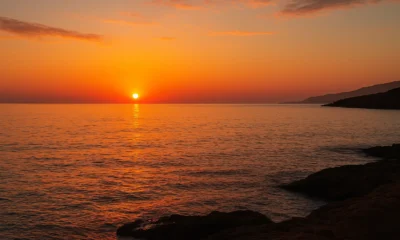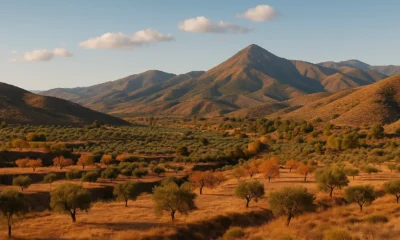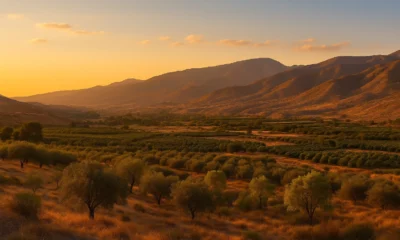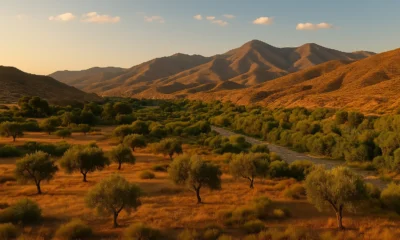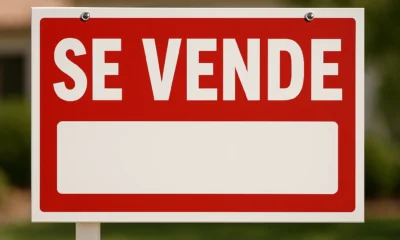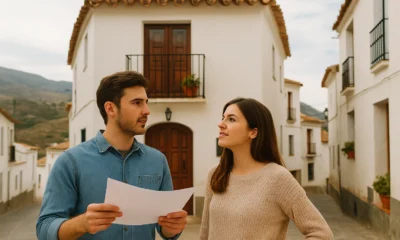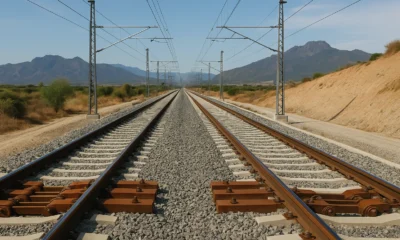Travel Tips
Alcudia de Monteagud Guide — Mountain Views, History & Peaceful Andalusian Life
Published October 23, 2025 | Category:
Towns & Villages ·
Travel Tips
TL;DR: Alcudia de Monteagud is a quiet white village in Almeria’s Sierra de los Filabres, known for its panoramic mountain views, Moorish heritage, and relaxed Andalusian pace of life.
Alcudia de Monteagud Guide. Discover Alcudia de Monteagud, Almeria — Mountain Views, History & Peaceful Andalusian Life
Table of Contents
- Introduction
- History & Heritage
- Nature & Hiking
- Culture & Local Life
- Gastronomy
- Festivals & Events
- Getting There & Accommodation
- Itineraries & Day Trips
- Practical Information
Introduction: A Hidden Balcony Over the Sierra de los Filabres
Perched high in the Sierra de los Filabres, Alcudia de Monteagud is one of Almeria’s smallest and most picturesque villages. With barely 150 inhabitants, this whitewashed hamlet offers sweeping views across the Almanzora Valley and beyond, making it a perfect destination for those seeking peace, nature, and authenticity. Its compact streets, white facades, and terraced landscape give it the charm of a mountain lookout — the very meaning of “Monteagud,” derived from Arabic, is “high hill.”
The village is surrounded by olive trees, almond groves, and rocky terrain that glows golden at sunset. From almost any spot, you can see distant peaks and the deep blue of the Andalusian sky. It’s the kind of place where time slows down, and life feels anchored in tradition.
History & Heritage
Like many villages in Almeria’s interior, Alcudia de Monteagud traces its origins back to the Moorish period. The name “Alcudia” comes from the Arabic al-kudiya, meaning “hill” or “elevated ground.” This hints at both its geography and its long history as a defensive settlement. During the Moorish era, the Sierra de los Filabres was home to numerous fortified hamlets that connected the valleys of Velefique, Tahal, and Benitagla.
After the Christian reconquest in the late 15th century, the village’s population was reshaped by repopulation from other parts of Spain. Traces of medieval architecture can still be seen in the narrow alleys and the stonework of older houses. The small Church of San Antonio de Padua now stands at the heart of the village, blending simplicity with a quiet sense of history.
Nature & Hiking
Despite its modest size, Alcudia de Monteagud offers remarkable access to some of Almeria’s most beautiful landscapes. The Sierra de los Filabres is a natural paradise for walkers — dotted with hiking trails that lead through pine forests, ravines, and panoramic ridges.
One popular route is the Sendero de Alcudia PR-A 363, a circular path that begins at the village and passes ancient threshing circles, stone terraces, and the remains of Moorish irrigation systems. The route rewards hikers with striking views over the valley and nearby villages such as Tahal and Benitagla.
In spring, wild almond blossoms paint the hillsides in shades of white and pink, while autumn brings mild weather perfect for outdoor exploration. Cyclists also enjoy the scenic mountain roads, particularly the route connecting Alcudia with Tahal and Benitagla.
Culture & Local Life
Life in Alcudia de Monteagud moves at a slower rhythm — locals greet each other by name, doors are left open in summer, and everyone gathers around the plaza in the evening. The community is close-knit, and the culture deeply tied to the land. Farming and small-scale livestock remain part of everyday life.
The village has a small museum and cultural hall managed by the Ayuntamiento de Alcudia de Monteagud, where events and exhibitions occasionally showcase traditional crafts or photography about the Sierra. Visitors often describe the village as “a balcony above Almeria” — peaceful, authentic, and almost timeless.
Gastronomy
Traditional Filabres cuisine is hearty and seasonal. Dishes often feature local almonds, olive oil, and grains cultivated in the surrounding terraces. Must-try meals include:
- Migas: Fried breadcrumbs with garlic, peppers, and sausage — the perfect dish after a hike.
- Olla de trigo: A rustic wheat stew with vegetables and pork.
- Gachas: Thick cornmeal porridge often served with honey or fried bread.
For desserts, try roscos de vino or almond cakes made locally, especially during festivals. Most residents prepare their own olive oil, cured meats, and preserves — if you’re lucky, you might be offered a taste at one of the small bars near the church square.
Festivals & Events
The highlight of the year is the Fiestas de San Antonio de Padua, celebrated every June. The event includes processions, music, fireworks, and community meals that bring together current and former residents who return from the coast to join the festivities. In addition, summer evenings often see small cultural events organized by the town hall, including open-air cinema or folk music gatherings.
For a province-wide overview of upcoming festivities and public holidays, check the official Almeria Local Holidays 2026 calendar, which includes all major events across the region.
Getting There & Accommodation
By car: Alcudia de Monteagud is located about 60 km north of Almeria city, roughly a 1 hour 15 minute drive via the A-92 and local mountain roads. The final stretch is winding but scenic, offering spectacular views as you climb towards the village.
By public transport: Limited — the best option is by car. Some regional buses run to Tahal or Chercos, but Alcudia itself is best reached independently.
Accommodation: There are a few casas rurales (rural guesthouses) available within the municipality and nearby villages. Staying overnight allows you to experience the quiet star-filled nights and early morning light over the Filabres mountains.
Itineraries & Day Trips
- Morning walk: Explore the village streets, visit the Church of San Antonio, and enjoy coffee at the plaza viewpoint.
- Half-day hike: Take the PR-A 363 route through the hills for panoramic views.
- Day trip idea: Combine a visit to Alcudia de Monteagud with Benitagla and Tahal for a circuit of small Filabres villages.
Practical Information
- Altitude: 1,010 m above sea level
- Population: Approx. 150 inhabitants
- Area: 15.5 km²
- Region: Sierra de los Filabres, Almeria province
- Town Hall: Plaza del Ayuntamiento, Alcudia de Monteagud (official website)
- Climate: Mountain Mediterranean — mild summers, cool nights, crisp air year-round
- Emergency numbers (Spain): 112 (General) · 061 (Medical) · 062 (Guardia Civil) · 085 (Fire)
For more peaceful mountain villages across the province, visit our Towns & Villages category or explore our Travel Tips for hiking routes and itineraries through inland Almeria.
Travel Tips
Almeria City Guide. Discover Almeria City — Culture, Cuisine, History & Mediterranean Life
Published October 27, 2025 | Category: Travel Tips
TL;DR: Almeria City is where the desert meets the Mediterranean — a bright, historic port full of Moorish charm, authentic tapas bars, sustainable innovation, and endless Andalusian sunshine.
Almeria City Guide. What to do in Almeria
Table of Contents
- Introduction
- History & Heritage
- Districts & Urban Life
- Top Attractions
- Walking Routes & Viewpoints
- Museums & Cultural Spaces
- Food, Tapas & Wine
- Port, Sustainability & Innovation
- Festivals & Nightlife
- Beaches & Nature
- Street Markets & Local Life
- Day Trips from Almeria City
- How to Get There
- Practical Information
Introduction
Bathed in light for more than 3,000 hours a year, Almeria City stands at the meeting point of desert and sea. Between the Mediterranean horizon and the dry hills of the Sierra de Alhamilla, it’s a city that blends Moorish architecture, relaxed Andalusian living, and striking modern contrasts. Compact, walkable, and full of colour, Almeria is the perfect base for discovering southeastern Spain.
The atmosphere is friendly and unhurried. People still greet each other in the streets, café terraces are filled even in winter, and the scent of the sea drifts through the old town. Every corner of Almeria feels both deeply local and unexpectedly cosmopolitan.
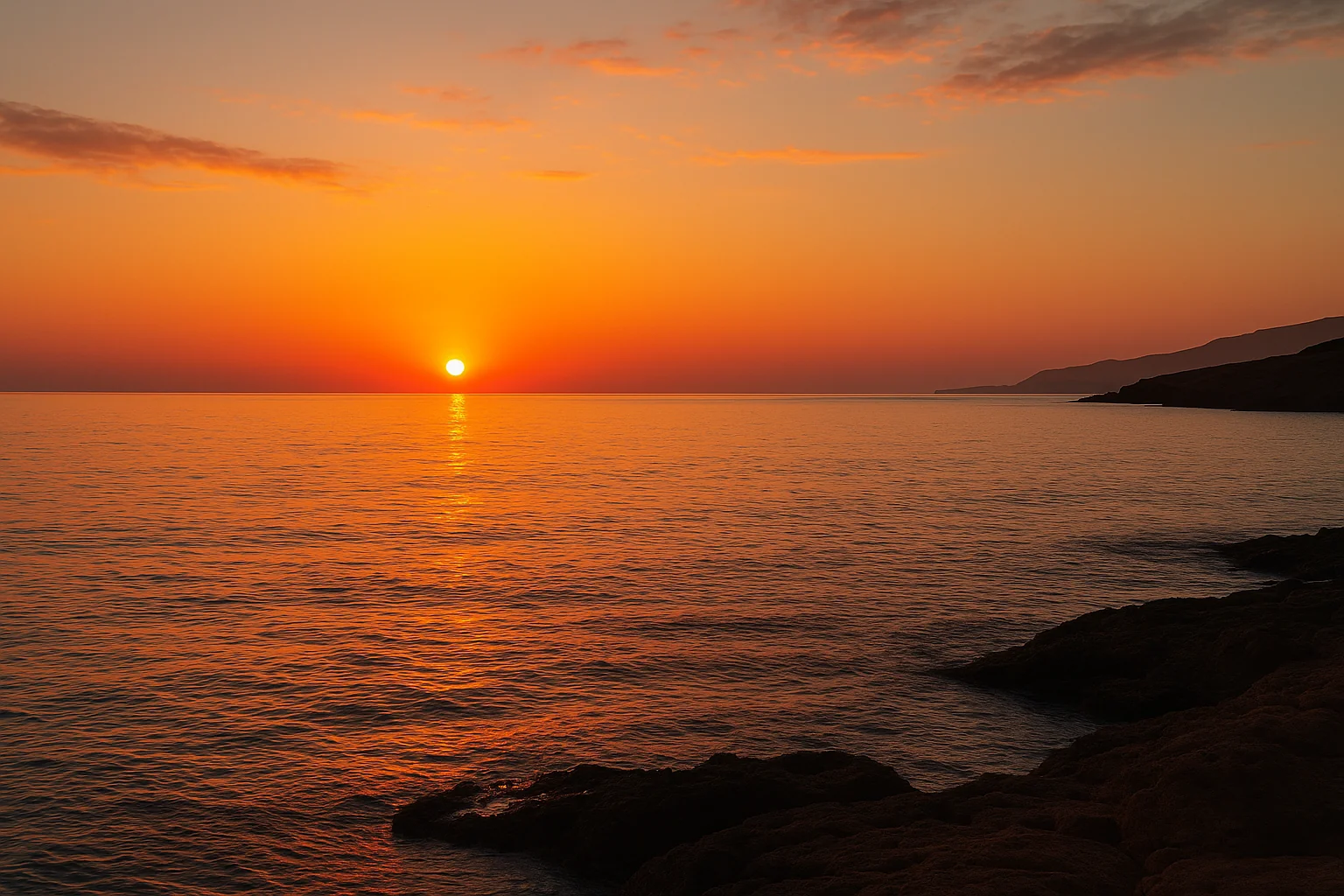
History & Heritage
Founded in the 10th century by Abd-ar-Rahman III as the fortified port of the Caliphate of Cordoba, Almeria — from Al-Mariyya, “the watchtower” — quickly became one of Al-Andalus’s key trading hubs. Its prosperity attracted merchants, poets and artisans whose legacy still shapes the old town today.
The Alcazaba of Almeria, a vast citadel rising above the city, remains one of Spain’s largest Islamic fortresses. After centuries of earthquakes, pirate raids and wars, the fortress was restored to its original grandeur and offers sweeping views of the port and sea. Nearby, the 16th-century Cathedral of Almeria blends Gothic, Renaissance and defensive architecture — a church built to withstand corsairs.
Through the 19th century Almeria thrived again on mining and trade. Later, the surrounding desert became a backdrop for classic Western films like The Good, the Bad and the Ugly. The film legacy continues today in Mini Hollywood and the annual FICAL Film Festival.
Districts & Urban Life
The historic centre, or Casco Histórico, is a maze of narrow Moorish streets that open onto elegant 19th-century boulevards. The Paseo de Almeria is the city’s main artery, lined with cafés and boutiques, while Puerta Purchena serves as the main meeting point for locals.
Under the Alcazaba lies La Chanca-Pescadería, a neighbourhood painted in pastel colours where fishermen once lived — still a favourite spot for photographers. Eastwards stretch the modern districts of Nueva Almeria and Retamar, home to beach apartments and the University Campus. Each part of the city carries a different rhythm, from student bustle to evening paseo elegance.
Top Attractions
Start with the Alcazaba, exploring its towers and gardens before descending to the cathedral square. Visit the Civil War Shelters — four kilometres of underground tunnels now open to visitors — and the Museo de Almeria, showcasing artefacts from prehistoric Los Millares to Roman mosaics.
For art, the Doña Pakyta Museum displays early 20th-century Andalusian painters, while the Centro Andaluz de la Fotografía holds rotating exhibitions. End your afternoon at Paseo Marítimo Carmen de Burgos, where the sea breeze and palm trees create a relaxed promenade atmosphere.
Walking Routes & Viewpoints
Almeria rewards walkers. Begin at the Cathedral and follow Calle Real up through La Chanca to reach the Alcazaba Viewpoint, with panoramic views over terracotta rooftops and the harbour. Continue to Cerro San Cristóbal for a broader panorama — especially stunning at sunset.
For a gentle city walk, trace the Rambla de Belén park from Puerta Purchena down to the seafront — a 30-minute stroll lined with fountains and jacarandas. Cyclists and runners favour the Paseo Marítimo, stretching several kilometres east towards El Toyo. Each route reveals how sea and desert coexist in daily life.
Museums & Cultural Spaces
Culture thrives in Almeria. Beyond its main museums, the Teatro Apolo hosts local theatre and flamenco shows, while the Auditorio Maestro Padilla stages orchestras and international festivals by the sea. The Almeria Art Centre inside a restored warehouse offers modern exhibitions and workshops.
Film heritage also runs deep — visit the small Casa del Cine, once the residence of John Lennon during the filming of How I Won the War, where he began writing “Strawberry Fields Forever”.
Food, Tapas & Wine in Almeria City
Named Spain’s Gastronomic Capital in 2019, Almeria keeps tapas culture alive: order a drink, get a free dish. It’s an essential local ritual — lively, social, and endlessly diverse.
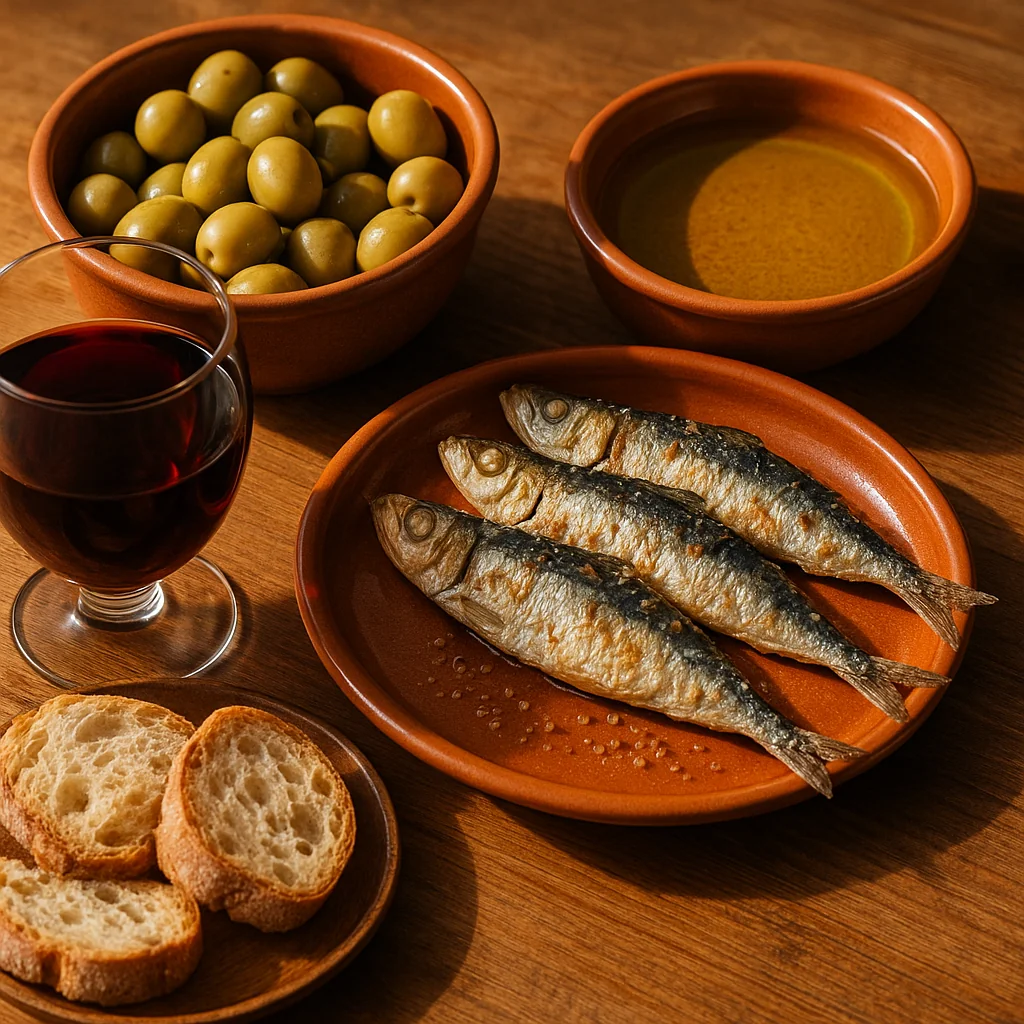
Tapas range from simple olives and anchovies to seafood stews, gurullos with rabbit, and grilled sardines caught that morning.
Head to Plaza Vieja or Calle Jovellanos for classics like Casa Puga, serving local wine and jamón ibérico since 1870. Around the Paseo Marítimo, beachside bars such as La Mala and Marhaba mix creative Mediterranean cuisine with sunset views. Every spring, the city hosts the Ruta de la Tapa de Almeria, where dozens of bars compete for the title of best tapa.
Almeria’s surrounding valleys produce excellent wines — especially from Laujar de Andarax and Ohanes — as well as extra-virgin olive oils, goat cheeses, and vegetables grown under the region’s famous greenhouses. Locals proudly say the province feeds Europe, yet the best produce still ends up on their own tables.
Port, Sustainability & Innovation
The Port of Almeria is both a gateway and a symbol of renewal. From ferries to Melilla and North Africa to fishing boats and cruise ships, the harbour remains vital to the city’s identity. In recent years, it has also become a pioneer in environmental management, introducing solar-powered facilities, shore-side electricity, and waste-reduction systems to cut maritime pollution.
Just east of the port, innovation meets ecology. Local researchers and startups are transforming plastic waste from the agricultural industry into fuel — a project that’s gained international attention. Learn more about this initiative in our feature Plastic to Biodiesel in Almeria.
Combined with regional solar farms and sustainable greenhouse practices, Almeria is quietly positioning itself as one of Spain’s leading hubs for clean energy and circular economy innovation.
Festivals & Nightlife
Each August the Feria de Almeria transforms the city with music, parades and fireworks honouring the Virgen del Mar. Earlier in the year, Semana Santa processions fill the old town with candles and drums, while November brings the International Film Festival (FICAL) celebrating Almeria’s cinematic legacy.
As night falls, Almeria comes alive with terrace bars, open-air concerts and flamenco shows in venues like Peña El Taranto. The student population keeps the nightlife vibrant, especially around Plaza Masnou and the seafront. It’s a safe, walkable city where locals linger late into the night over wine and conversation.
Beaches & Nature
Within city limits, El Zapillo and San Miguel beaches are lively and family-friendly, while Retamar and El Toyo near the airport offer quieter sands and boardwalks.
To the east, the volcanic cliffs of Cabo de Gata Natural Park unfold with hidden coves such as Monsul and Genoveses — easily reached by car or bus.
Street Markets & Local Life in Almeria City
Almeria’s mercadillos bring colour and rhythm to every neighbourhood. Open a market below to see key details (day, hours, location, stalls).
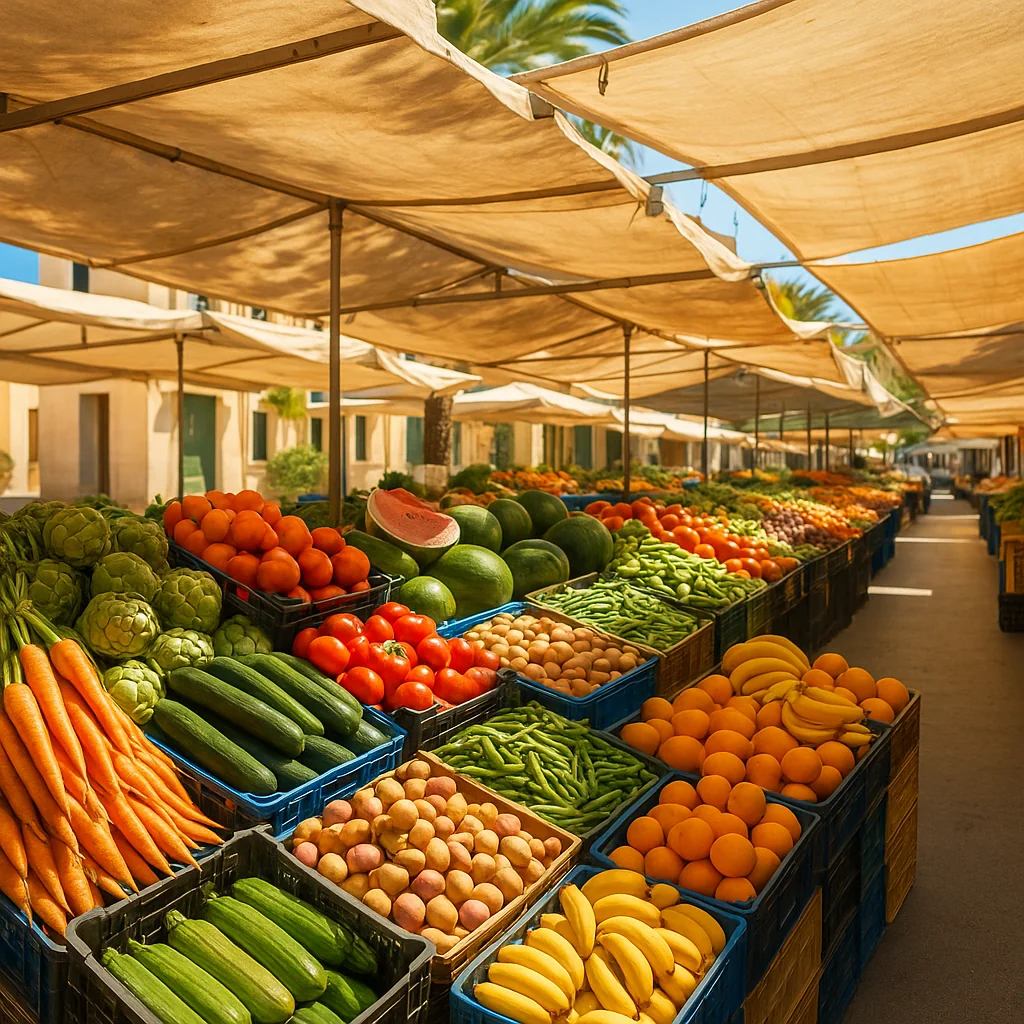
Mercadillo del Estadio de los Juegos Mediterráneos (Tue)
| Details | Information |
|---|---|
| Market day | Tuesday |
| Type | General goods market |
| Location | Calle del Acebo, near the Estadio de los Juegos Mediterráneos |
| Hours | 08:30 – 14:00 |
| Stalls | ≈ 320 |
One of the largest markets in Almeria, with clothing, shoes, produce, plants and household goods.
Mercado de la Plaza Pavía (Mon–Sat)
| Details | Information |
|---|---|
| Market days | Monday – Saturday |
| Type | General goods & produce market |
| Location | Plaza Pavía, city centre |
| Hours | 09:00 – 14:00 |
Main covered market with fresh fish, fruit and vegetables; busiest in the morning.
Mercadillo de Cabo de Gata (Sat)
| Details | Information |
|---|---|
| Market day | Saturday |
| Type | General goods market |
| Location | Plaza Malvasía, Cabo de Gata |
| Hours | 08:30 – 14:00 |
| Stalls | ≈ 30 |
Small, friendly seaside market—great to pair with a beach walk.
Mercadillo de El Alquián (Sun)
| Details | Information |
|---|---|
| Market day | Sunday |
| Type | General goods market |
| Location | Ctra. Níjar – El Alquián, near Almeria Airport |
| Hours | 08:30 – 15:00 |
| Stalls | ≈ 115 |
Lively Sunday market popular with families and bargain hunters.
Mercadillo de Los Ángeles (Fri)
| Details | Information |
|---|---|
| Market day | Friday |
| Type | General goods market |
| Location | Calle Vecina Concha Ruiz, Los Ángeles district |
| Hours | 08:30 – 14:00 |
| Stalls | ≈ 265 |
Traditional neighbourhood market known for textiles and household items.
Mercadillo de la Bola Azul (Mon)
| Details | Information |
|---|---|
| Market day | Monday |
| Type | General goods market |
| Location | Calle Haza de Acosta, Bola Azul area |
| Hours | 08:30 – 14:00 |
| Stalls | ≈ 200 |
Close to the hospital zone; handy for everyday shopping and fresh produce.
Mercado del Auditorio Maestro Padilla (Sat)
| Details | Information |
|---|---|
| Market day | Saturday |
| Type | General goods market |
| Location | Auditorio Maestro Padilla, seafront zone |
| Hours | 08:30 – 14:00 |
| Stalls | ≈ 230 |
By the sea near the auditorium—great weekend vibe for families and photographers.
Set beside the sea near the auditorium, this Saturday market combines ocean views with a lively weekend vibe — perfect for families and photographers alike.
Together these markets form the heartbeat of Almeria’s social life: a weekly meeting place full of colour, aromas, and Mediterranean character.
Day Trips from Almeria City
Within an hour you can explore extraordinary landscapes and villages:
- Tabernas Desert — Europe’s only desert, known for its western film sets and dramatic canyons.
- Níjar Village — famous for pottery, woven rugs and whitewashed alleys.
- Cabo de Gata Beaches — unspoilt coves such as Monsul, Media Luna and Genoveses.
- Alpujarra Almeriense — mountain villages like Laujar de Andarax surrounded by vineyards and chestnut forests.
- Roquetas de Mar — a resort town west of the capital with a long promenade and water-sports facilities.
All destinations are reachable by car or organised excursion, making Almeria a perfect hub for slow travellers.
How to Get to Almeria City
Almeria City is easily accessible by all major routes in southeastern Spain. The Almeria Airport (LEI) lies just 9 km east of the city centre, with regular flights to Madrid, Barcelona and several European destinations. Buses and taxis connect the airport with the main station area at Plaza de las Velas.
Long-distance buses link Almeria with Granada, Malaga, Murcia and Madrid, while regional trains connect with destinations along the coast. The port also serves regular ferry routes to Melilla and North Africa.
Inside the city, local buses cover most neighbourhoods, and the compact layout makes it easy to explore on foot or by bike along the Paseo Marítimo and Rambla avenues.
Practical Information
- Region: Capital of Almeria Province, southeastern Spain.
- Municipal info: Ayuntamiento de Almeria — services, events and notices.
- Tourist Office: Plaza de la Constitución | +34 950 210 538
- Transport: Airport (LEI) 9 km; bus & train station near Plaza de las Velas; ferry links to Melilla and North Africa.
- Emergency numbers (Spain): 112 (General) · 061 (Medical) · 062 (Guardia Civil) · 085 (Fire)
For a province-wide overview of upcoming festivities and public holidays, check the
official Almeria Local Holidays 2026 calendar, which includes all major events across the region.
For more updates from across the province, visit our Towns & Villages category.
Travel Tips
Alicun Guide. Discover Alicun, Almeria — Nature, Heritage & Valley Tranquillity
Published October 23, 2025 | Category: Travel Tips
TL;DR: Alicun is a peaceful Andarax valley village in Almeria, known for its olive groves, mountain scenery and authentic Andalusian rhythm — perfect for slow travel, short hikes and rural discovery.
Alicun Guide. Discover Alicun, Almeria — Nature, Heritage & Valley Tranquillity
Table of Contents
- Introduction
- History & Heritage
- Nature & Surroundings
- Culture & Local Life
- Festivals & Events
- Local Market
- Getting There & Accommodation
- Travel Tips
Introduction: A valley village with deep rural roots
Nestled in the lower Andarax valley between the Sierra de Gador and Sierra Alhamilla, Alicun offers a picture of traditional Andalusian village life. With around 250 inhabitants, it’s one of the smallest municipalities in the province of Almeria — quiet, authentic, and surrounded by olive groves and almond fields that paint the hillsides each spring.
Despite its size, Alicun maintains its own Ayuntamiento (town hall), local festivities, and a handful of family-run bars and shops that cater to residents and weekend visitors. The village’s position near the Diputación de Almería network of rural routes makes it a pleasant stop for walkers exploring the Andarax basin.
History & Heritage
Alicun’s origins trace back to Moorish Al-Andalus, when irrigation channels transformed these dry foothills into fertile farmland. Like other Andarax towns, it witnessed repopulation after the Morisco expulsion and gradual adaptation to the valley’s microclimate. Today, the village preserves its traditional street layout — narrow, whitewashed lanes leading to small squares where the church tower overlooks the rooftops.
The heart of Alicun is defined by the Iglesia de San Sebastián, a 19th-century parish built over earlier foundations. Around it, you’ll find traces of traditional architecture with stone façades and wooden balconies, reflecting rural craftsmanship that still survives in older homes.
Nature & Surroundings
Alicun sits on the fertile banks of the Andarax River, which nourishes its groves of olive, orange, and almond trees. Walking paths link the village to neighbouring towns like Alhabia and Alhama de Almeria, offering scenic views of the valley and the Sierra de Gador’s reddish slopes.
For outdoor enthusiasts, short circular routes follow irrigation ditches and hillside tracks, while longer hikes ascend into the nearby mountains. Spring is especially beautiful, when almond blossoms turn the valley pale pink and white.
Culture & Local Life
Life in Alicun moves at a gentle pace. Mornings start early, with locals gathering for coffee in the plaza or tending to smallholdings. Traditional festivals, local markets, and community meals punctuate the year — offering visitors a warm introduction to authentic inland Almeria.
Although the village is small, residents take pride in maintaining long-standing customs and religious processions, particularly those tied to the local patron saint and harvest season.
Festivals & Events
Alicun celebrates two main fiestas locales each year:
- 20 January — Local holiday (Fiesta de San Sebastián, the town’s patron saint).
- 26 August — Local holiday marking the summer celebrations with music, games, and traditional events.
Visitors during these dates will find the streets filled with music, stalls, and local food, as families and neighbours celebrate in the heart of the village.
For a province-wide overview of upcoming festivities and public holidays, check the
official Almeria Local Holidays 2026 calendar, which includes all major events across the region.
Mercadillo de Alicun
While Alicun itself does not host a large weekly market, residents often visit nearby Alhabia or Alhama de Almeria on market days (Monday and Friday respectively). These markets offer fresh produce, clothing, and local goods — ideal for experiencing the valley’s community life.
Getting There & Accommodation
By car: Alicun lies about 30 km from Almeria city. Take the A-92 and turn off toward Alhama de Almeria, following signs into the valley. Parking is free and easy around the village entrance.
By bus: Limited regional services connect Alicun with nearby towns — check schedules in advance.
Stay: Accommodation options include small rural houses (casas rurales) and guest rooms in neighbouring villages like Alhama or Alhabia.
Travel Tips
- Visit in spring to see the almond blossoms and mild weather.
- Bring walking shoes — most village streets are cobbled and hilly.
- Try local olive oil and almonds sold directly by residents.
Practical Information
- Region: Lower Andarax valley, between Sierra de Gador and Sierra Alhamilla.
- Municipal info: Ayuntamiento de Alicun — contacts, notices and local services.
- Stats & map: Junta de Andalucía — SIMA municipal fiche for Alicun (geographical and demographic data).
- Nearby towns: Alhabia (2.5 km) and Alhama de Almeria (7 km), both accessible via local roads through the valley.
- Tourist info: Diputación de Almería — provincial tourism and cultural resources.
- Emergency numbers (Spain): 112 (General) · 061 (Medical) · 062 (Guardia Civil) · 085 (Fire)
For more village destinations across the province, visit our Towns & Villages.
-
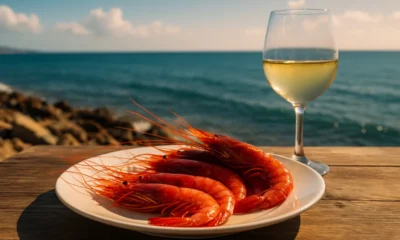
 Almeria News5 days ago
Almeria News5 days agoRed Prawn Festival Garrucha 2025 Confirmed | Programme, Dates & Events
-
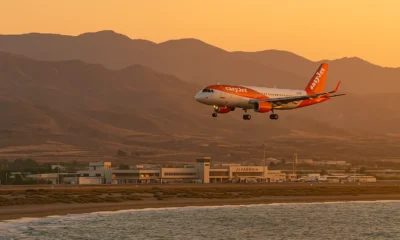
 Almeria News3 days ago
Almeria News3 days agoEasyJet launches new Liverpool–Almeria flight
-
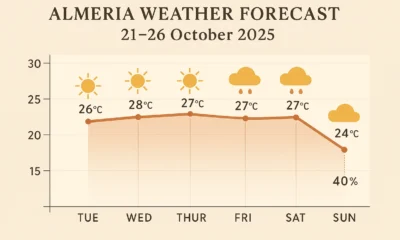
 Almeria News7 days ago
Almeria News7 days agoAlmeria Weather Forecast 21–26 October 2025
-
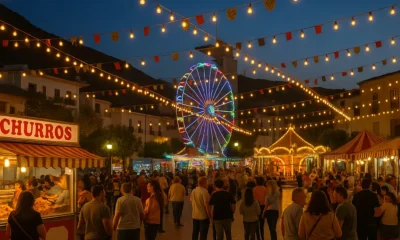
 Events4 days ago
Events4 days agoAlbox All Saints Fair 2025 — Five Days of Music, Food & Tradition



















